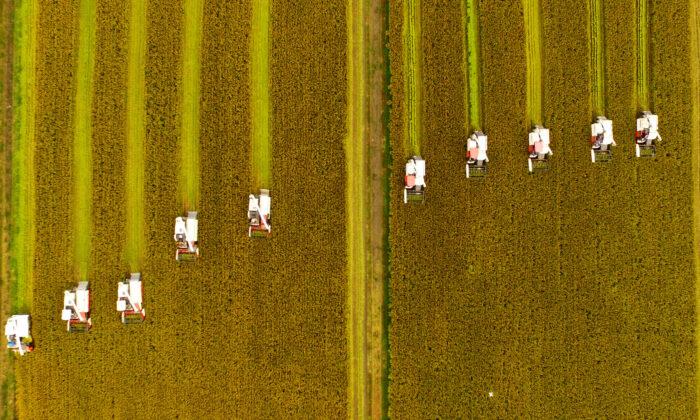China made the first move toward the Sino-U.S. trade war truce by purchasing nearly 600,000 tons of U.S. soybeans as concerns rise over its domestic food security.
Reuters called China placing a large order for U.S. soybeans on the day before the first meeting between President Donald Trump and Chinese leader Xi Jinping in seven months, an “apparent goodwill gesture.”
But with Chinese farmers burying pigs alive as
African swine fever spreads to every province and
fall armyworms having gobbled up crops across the south and expected to move north, confidence in the Chinese Communist Party (CCP) is at risk of eroding in the run-up to the
October 1 mass activities celebrating the 70th Anniversary of the People’s Republic of China.
Chinese
agricultural employment plunged from about 33 percent of workers in 2006 to 17.5 percent in 2017, as young people left rural farms for coastal export factories. But over a third of Chinese still live in agricultural communities and
food consumes an average of about 35 percent income for 776 million Chinese workers.
The U.S. National Institute of Health study found that as Chinese ate more meat and grains during the economic boom between 1975 and 2010, the
average height of Chinese children increased steadily without any tendency to plateau. The largest gains were urban 13-year-olds with 3.5 inches (9 centimeters) for boys and 2.8 inches (7 centimeters) for girls, but all Chinese youth demographics saw significant increases in height.
The biggest contributor to higher Chinese meat consumption is pork—about 38 kilograms a year accounts for 70 percent or more of meat products consumed regularly.
The average female hog in the United States gives birth three times a year to litters of 11 to 13 piglets. After 3 weeks of weaning, piglets move to a separate nursery barn where they gain about 4 lbs. a day by eating soybean meal and corn for 8 weeks. Hogs then move to the finishing barns and mature at 280 lbs. in 16 weeks, before being harvested.
Chinese research studies reveal that domestic pig farming is carried out in backyard, small, and large commercial farms. Backyard farmers that account for about 30 to 40 percent of China’s 490 to 618 million pigs, “typically sell only 5 to 10 pigs per year” to local market fairs for as little as about $40 each.
Farmers offset low rural prices by letting pigs roam and feeding them food scraps, including meat waste. Referred to as “swill,” such garbage is
prohibited as pig feed by the USDA’s Animal and Plant Health Inspection Service.
At least 10 large pork producers with over 10,000 sows has put many small farmers out of business. Because there has been very little inspection of farms and meat packing houses for domestic consumption, China has had many domestic outbreaks of high fever blue-ear disease, porcine circovirus and classical swine fever, including a 2007 outbreak that infected 50 million pigs.
U.S. soybean prices averaged $7 per bushel from 1973 to 2000. But after China gained entry into the World Trade Organization in 2001, exports of soybeans to China grew from $1 billion to peak at $14.9 billion in 2012, and
prices rose to $17 per bushel.
U.S. soybean exports to China stalled at about $12.5 billion from 2013 to 2017, but plunged in 2018 due to retaliatory tariffs and the China African swine fever outbreak.
The Chinese regime took measures to stamp out the disease by quarantining and culling hog herds. But
such actions without sufficient compensation may have been counterproductive as trade moved to “uncontrolled markets, or more distant points of sales, increasing disease transmission instead of preventing it.”
With African swine fever reaching pandemic status, China issued new domestic
inspection rules in early May that will require slaughterhouses and processing plants to start testing for African swine fever by July 1. Prices fell as the hog sow population fell from 50 million to 38 million. But with supply shriveling, pork prices were expected to move much higher later this year.
The U.S. FDA Food Safety Modernization Act of 2015 provides that all U.S. processors of animal food must follow ‘Current Good Manufacturing Practices’ contamination controls and appropriate sanitation procedures, practices, and processes to prevent hazards such as environmental pathogens and hazards from employees handling animal food.
The Chinese regime has never conducted effective testing of domestic plant-based animal feed supplies. The issue has caused greater alarm after Kansas State University
reported in February that animal feed exposed to African swine fever can “easily be transmitted orally” during hog “drinking and feeding behaviors.”
The size of the new Chinese soybean order is extraordinary, given that the FDA reported on-farm soybeans stocks on June 1 totaled only about 53.6 tons, and flooding has restricted 2019 soybean plantings through June 3 to 39 percent of the annual average, according to the June 3 Crop Progress
report.
U.S. soybean prices that had been trading at a 10 year low of $9 a bushel are now expected to move higher.




